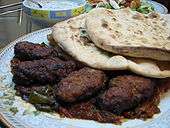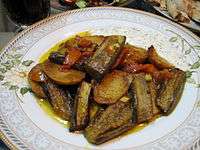Afghan cuisine
Afghan cuisine (Dari: آشپزی افغانستان, Pashto: د افغانستان خواړه) is largely based upon the nation's chief crops, such as wheat, maize, barley and rice. Accompanying these staples are native fruits and vegetables and dairy products such as milk, yogurt, and whey. The nation's culinary specialties reflect its ethnic and geographic diversity.[1] Afghanistan is known for its high-quality pomegranates, grapes, and sweet, rugby-football shaped melons.[2] The national dish of Afghanistan is the rice dish kabuli palaw.[3]

Major foods


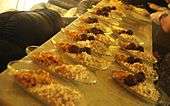
Types of rice dishes
Moi
Challow is served mainly with qormas (korma; stews or casseroles).
Palaw
Cooked the same as challow, but meat and stock, qorma, herbs, or a combination are blended in before the baking process. This creates elaborate colors, flavors, and aromas from which some rice is named. Caramelized sugar is also sometimes used to give the rice a rich brown color. Examples include:
- Kabuli palaw – a national dish.[3] Meat and stock is added, and topped with fried raisins, slivered carrots, and pistachios.
- Yakhni Palaw – meat and stock added. Creates a brown rice.
- Zamarod Palaw – spinach qorma mixed in before the baking process, hence 'Camaro' or emerald.
- Bore Palaw – former Lawand added. It creates yellow rice.
- Landi Palaw- Rice with Livestock that was salted and rested in the sun it is a tradition in Afghanistan among many.
- Bojan-e-Roomi Palaw – former Bonjan-e-Roomi (tomato qorma) added during the baking process. It creates red rice.
- Serkah Palaw – similar to yakhni pulao, but with vinegar and other spices.
- Sherbet Palaw – fresh dill, raisins added during the baking process.
- Narenj Palaw – a sweet and elaborate rice dish made with saffron, orange peel, pistachios, almonds, and chicken.
- Maash Palaw – a sweet and sour pulao baked with mung beans, apricots, and bulgur wheat. Exclusively vegetarian.
- Alou Balou Palaw- a sweet rice dish with cherries and chicken.
Qormah
Qormah/Korma is a stew or casserole, usually served with chalau rice.[1] It is always onion and tomato based; onions are fried, tomato is added, including a variety of fruits, spices, and vegetables, depending on the recipe. And finally the main ingredient is added, which can be meat or/and vegetables. The onion is caramelized and creates a richly colored stew. There are over 100 qormahs. Below are some examples:
- Qormah e Gosht – literally translates to meat qormah, is usually the main qormah served with Palaw in gatherings.
- Qormah e Alou-Bokhara wa Dalnakhod – onion-based, with sour plums, lentils, and cardamom. Veal or chicken.
- Qormah e Nadroo – onion-based, with yogurt, lotus roots, cilantro, and coriander. Lamb or veal.
- Qormah e Lawand – onion-based, with yogurt, turmeric, and cilantro. Chicken, lamb, or beef.
- Qormah e Sabzi – sauteed spinach and other greens. Lamb.
- Qormah e Shalgham – onion-based, with turnips and sugar; sweet and sour taste. Lamb.
Note that Afghan karahi (curry) does exist. The difference between qormah and karahi is that unlike qormah, karahi is prepared in a wok like cookware in which all ingredients are added at the same time fried and then let simmer. While qormah, oil and onion are caramelized first and then tomato and spices are added, and finally the main ingredient.
Mantu
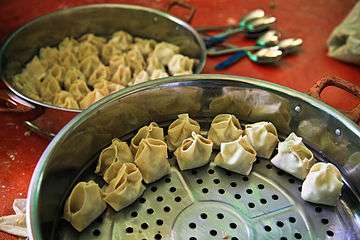
Known as khameerbob and often eaten in the form of dumplings. These native dishes are popular, but due to the time-consuming process of creating the dough for the dumplings, they are rarely served at large gatherings such as weddings, but for more special occasions at home:
- Mantu – Dumplings filled with onion and ground beef or lamb. Mantu is steamed and usually topped with a tomato-based sauce and a yogurt- or qoroot-based sauce. The yogurt-based topping is usually a mixture of yogurt and garlic and split chickpeas. The qoroot-based sauce is made of goat cheese and is also mixed with garlic; a qoroot and yogurt mixture will sometimes be used. The dish is then topped with dried mint and coriander.
- Ashak – a dish associated with Kabul. Dumplings filled with a mixture largely compromising of leeks. Ashak is topped with garlic-mint qoroot or a garlic yogurt sauce, sautéed tomatoes, red kidney beans and a well-seasoned ground meat mixture.
Each family or village will have its own version of mantu and ashak, which creates a wide variety of dumplings. A local plant called gandana is cut and used as dumplings; it is boiled and fried in ghee with pudina powder added over the soup, with vinegar
In the form of noodles, pasta is also commonly found in aush, a soup with several regional variations.
Kebab
Afghan kebab is most often found in restaurants and outdoor vendor stalls. The most widely used meat is lamb. Recipes differ with every restaurant. Afghan kebab is served with naan, rarely rice, and customers have the option to sprinkle sumac or ghora, dried ground sour grapes, on their kebab. The quality of kebab is solely dependent on the quality of the meat. Pieces of fat from the sheep's tail (jijeq) are usually added with the lamb skewers to add extra flavor.
.jpg)
Other popular kebabs include the lamb chop, ribs, kofta (ground beef) and chicken, all of which are found in better restaurants.
Chapli kebab, a specialty of Eastern Afghanistan, is a patty made from beef mince. It is a popular barbecue meal in both Pakistan and Afghanistan. The word Chapli comes from the Pashto word Chaprikh, which means flat. It is prepared flat and round, and served with naan. The original recipe of chapli kebab dictates a half meat (or less), half flour mixture, which renders it lighter in taste and less expensive.
Chicken
Afghani Chicken or Murgh Afghani is a classic example of one of the most famous dishes from Afghanistan. Chicken dishes are usually found in restaurants and outdoor street vendor stalls. Unlike Indian Cooking style, chicken in Afghan cuisine is often used to be a Halal. Cream, butter, curd are the accustomed ingredients used in all the chicken recipes whether an appetizer or main course.
Quroot
Quroot (or Qoroot) is a reconstituted dairy product. It was traditionally a by-product of butter made from sheep or goat milk. The residual buttermilk remaining after churning of the butter is soured further by keeping it at room temperature for a few days, treated with salt, and then boiled. The precipitated casein is filtered through cheesecloth, pressed to remove liquid, and shaped into balls. The product is thus a very sour cottage cheese. Quroot is hard and can be eaten raw. It is typically served with cooked Afghan dishes such as Ashak, Mantu, and Kichri Qoroot, among others.
Other Afghan food items

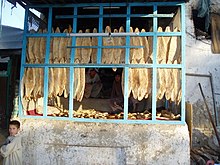
- Afghan Kofta (meatball)
- Afghan Kaddu Buranee (sweet pumpkins)
- Afghan salad
- Afghani burger
- Ashak (vegetable and chive-filled dumplings topped with tomato and yogurt sauces)
- Aush (hand-made noodles)
- Bichak (small turnovers with various fillings, including potato and herbs, or ground meat)
- Shorba (Afghan soup similar to borscht)
- Dolma (stuffed grape leaves)
- Londi, or gusht-e-qaaq (spiced jerky)
- Kichri (sticky medium-grain rice cooked with mung beans and onions)
- Badenjan (cooked eggplant with potatoes and tomatoes)
- Badenjan-Burani (fried slices of eggplant, topped with a garlic sour cream sauce and sprinkled with dried mint)
- Baamiyah (okra)
- Bolani also called “Buregian” in southern Afghanistan (somewhat similar to Quesadilla)
- Halwaua-e-Aurd-e-Sujee
- Nan-e-Afghan/Nan-e-Tandoori (Afghan bread cooked in a vertical ground clay oven, or a tandoor)
- Nan-e-Tawagy (flat bread cooked on a flat pan)
- Osh Pyozee (stuffed onion)
- Mantu (meat dumplings), usually served under a yogurt-based white sauce.
- Qabili Palau (traditional rice dish)
- Dampukht (steamed rice)
- Bonjan Salad (spicy eggplant salad)
- Shor-Nakhud (chickpeas with special toppings)
- Nan (a type of flat-bread cooked in an oven made from a hole in the ground. The bread is slapped onto the stone wall to cook)
- Maast or labanyat (type of plain yogurt)
- Chakida or chakka (type of sour cream)
- Salata (tomato and onion-based salad, often incorporating cucumber)
- Sheer Berinj (rice pudding)
- Cream roll (pastry)
- Baklava (pastry)
- Afghan Cake (similar to pound cake, sometimes with real fruit or jelly inside)
- Gosh e feel (thin, fried pastries covered in powdered sugar and ground pistachios)
- Kebab (similar to Middle Eastern style)
- Fernea Pashto/Persian: فر نی], sometimes spelled feereny (milk and cornstarch help make this very sweet, similar to rice pudding without the rice)
- Mou-rubba (fruit sauce, sugar syrup and fruits, apple, sour cherry, or various berries, or made with dried fruits. "Afghan favorite is the Alu-Bakhara".)
- Kulcha/Koloocheh (variety of cookies, baked in clay ovens with char-wood)
- Narenge Palau (dried sweet orange peel and green raisins with a variety of nuts, mixed with yellow rice glazed with light sugar syrup)
- Nargis kabob (egg-based angel hair pasta soaked in sugar syrup, wrapped around a piece of meat)
- Torshi (eggplant and carrot mixed with other herbs and spices, pickled in vinegar and aged)
- Khoujoor[4] (Afghan pastry, deep-fried, oval shaped, similar to doughnuts in taste)
- Afghan Chatni[5] made with fresh Coriander leaves
- Kalah Chuquki or Kalah Gunjeshk (battered deep fried bird heads)
- Kalah Pacha (lamb or beef head/feet cooked in a broth, served in bowls as a soup dish or in a stew or curry)
- Shami kabob (cooked beef blended with spices, flour and eggs, rolled in hot dog shapes or flat round shapes and fried)
- Shorwa-E-Tarkari[6] (meat and vegetable soup)
- Chopan [Pashto/Persian: چوپان, meaning "shepherd"] kabob [Pashto/Persian: کباب] (lamb chops, skewered and grilled on charcoal)
- Delda or Oagra (mainly a Southern dish, made from the main ingredient of split wheat and a variety of beans mixed)
- Owmach (made from flour; a soup-like dish, very thick and pasty)
- Peyawa or Eshkana (a soup based on flour, very similar to a gravy, but mixed with chopped onion, potatoes and eggs)
- Aushe Sarka (vinegar-based flat noodle soup, taste very similar to Chinese hot and sour soup)
- Maushawa (mixed beans and tiny meat balls, served in a bowl)
- Sheer khurma, a traditional dessert
 Baamiyah (okra), also served for lunch or as a side dish
Baamiyah (okra), also served for lunch or as a side dish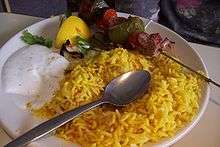
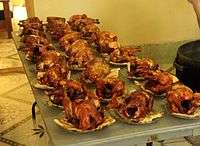 Roasted chicken
Roasted chicken
Drinks
Doogh (also known by some Afghans as shomleh or shlombeh) is a cold drink made by mixing water with yogurt and then adding fresh or dried mint. Some variations of doogh include the addition of crushed or diced cucumber chunks. It is the most widely consumed drink in Afghanistan, especially during lunchtime in summer. Doogh can be found at most Afghan grocery stores and is served in restaurants.
By region and ethnicity
Pashtun cuisine
Pashtuns are the largest ethnic group of Afghanistan, constituting about 42% of the country's population.[7] A major dish in Pashtun culture is Sohbat, used in traditional gatherings and events.[8] other major Pashtun dishes (some of which overlap with other ethnicities and regions) include lamb-skewered sajji and chapli kebab. Dampukht is steamed meat khaddi kebab is the Afghan shashlik, grilled on an open fire on a spit.[9]
Pashtun cuisine is meat-heavy and is often offered with caramelized Rice. There are regional variants: for example, the dish known as “Bolani” in the north and east is often called “Borogyen” in the south and west.
Common summer beverages include Shlombeh, also known in Persian as Doogh, a drink consisting of liquid yogurt, mint, and bedreng (Afghan cucumber). Sherbet is an ice sugared cold drink. Sheer yakh is a sweet ice-like product literally translating to "Cold Milk".[9]
Hazara cuisine
The Hazara people in central Afghanistan (in the region of Hazarajat) and western Pakistan (Balochistan province) have their own food – Hazaragi cuisine. Since the Hazara people share some similarities with neighboring regional cuisines, the food is mainly influenced by Central Asian, Persian and South Asian cuisines. However, the way of cooking and culinary methods are different in some of the dishes between these neighboring cuisines.
In Hazara cuisine, the Hazara people used a large proportion of high-protein food such as meat and dairy products as well as plenty of oil when cooking. Rather than a wide selection of dishes, their meal usually consists of only one type of food.[10]
Below are some famous dishes in Hazaragi cuisines:
AASH – A healthy food with its own taste, one of the most common foods in a Hazaragi restaurant. Aash is easily made from flour, therefore, some housewives make aash at home and sell it to retailers to earn money. As the main ingredient is flour, patients can eat it easily without any concern. It is also a feast food and served with minced meat, vegetables, and lentils at parties.[11]
DALDA – The most favorite food for adults. People eat it with their hands. It looks like wheat when it is raw, but changes in appearance after being cooked. It is served with some boiled oil in the middle and has its own taste.[11]
NANTAR/YAKHNI – Yahkni can be a soup of chicken, goat, cow or sheep. After putting some bread (nan) in the bowl with the soup, it becomes Nantar, meaning "bread is wet". The food can be eaten with a spoon, but it tastes better when eaten with the hands.[11]
HALWA-E-SAMANAK – Not an ordinary food, it is not easily made as you have to be strong enough to mix all the ingredients with a spoon, but it is made as daily food for dinner or lunch. Halwa refers to holidays like Muharram (holy month) or funerals.[11]
Special occasions
Serving tea and white sugared almonds is a familiar custom during Afghan festivals.[1] Eid-e-Qorban is celebrated at the end of the Haj, the pilgrimage to Mecca, when families and friends come visiting each other to drink a cup of tea together and share some nuts, sweets, and sugared almonds called noql.
See also
References
- Brittin, Helen (2011). The Food and Culture Around the World Handbook. Boston: Prentice Hall. pp. 20–21.
- "Rare Heirloom Seeds – Baker Creek Heirloom Seeds". Baker Creek Heirloom Seeds. Archived from the original on 2016-03-04. Retrieved 2013-10-28.
- Ali, Tanveer (31 July 2012). "Everything You Need To Know About Afghan Food". foodrepublic. Retrieved 2014-02-19.
- Khoujoor
- Afghan Spicy Chatni
- Shorwa-E-Tarkari
- "Ethnic Groups Of Afghanistan".
- "Sohbat: The Pashtun Dish That Brings People Together". www.gounesco.com.
- Safia Haleem (1 May 2013). Pakistan – Culture Smart!: The Essential Guide to Customs & Culture. Kuperard. pp. 98–. ISBN 978-1-85733-678-8.
- "Hazaras cultures". Retrieved 2018-09-21.
- "Hazaragi Foods". Retrieved 2018-09-21.
Further reading
- Helen J. Saberi (1997). "Travel and Food in Afghanistan". In Harlan Walker (ed.). Food on the Move: Proceedings of the Oxford Symposium on Food and Cookery, 1996. Prospect Books. ISBN 978-0-907325-79-6.
| Wikimedia Commons has media related to Cuisine of Afghanistan. |
